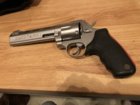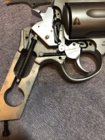One problem I have with jacketed Laguna is,the soft edges created by the forming dies. What I've learned shooting cast varmint is,the sharper all the leading edges are,the more damaging it is to tissue.
So,would look(or possibly modify) for the sharpest meplats in whatever weight bullet your rig prefers. And can not overstate accuracy.... both the rig's and your field shots. Find a mid level load that will build confidence and muscle memory,and dry fire about every day. Am sure you're already doing a lot of this stuff,just gotta keep pounding away at the fundamentals.
One trick was posted in another thread about backing yourself up against a truck tire or tree,whilst sitting. Using crossed shooting sticks. Just sayin,if you're hunting you got to get off the bench. This keeps your torso in check. Wear a ball cap,bring the bill down as low as possible while getting the sights aligned..... it increases your depth of focus.
Another "trick" is,if you're having trouble focusing on fr site..... during dry fire,looking out a window,you can use the window screen as a "check system" for your focus. Meaning,get your head about 6' from screen looking out with pistol at full extension...... you should be able to hold within a cpl screen "squares". It's a great way to shorten up your focus(it's a lot shorter focus shift at 6', down to your arms length than say a can or something,50yds out in the yard). Do it enough and watch your scores.
So,would look(or possibly modify) for the sharpest meplats in whatever weight bullet your rig prefers. And can not overstate accuracy.... both the rig's and your field shots. Find a mid level load that will build confidence and muscle memory,and dry fire about every day. Am sure you're already doing a lot of this stuff,just gotta keep pounding away at the fundamentals.
One trick was posted in another thread about backing yourself up against a truck tire or tree,whilst sitting. Using crossed shooting sticks. Just sayin,if you're hunting you got to get off the bench. This keeps your torso in check. Wear a ball cap,bring the bill down as low as possible while getting the sights aligned..... it increases your depth of focus.
Another "trick" is,if you're having trouble focusing on fr site..... during dry fire,looking out a window,you can use the window screen as a "check system" for your focus. Meaning,get your head about 6' from screen looking out with pistol at full extension...... you should be able to hold within a cpl screen "squares". It's a great way to shorten up your focus(it's a lot shorter focus shift at 6', down to your arms length than say a can or something,50yds out in the yard). Do it enough and watch your scores.












